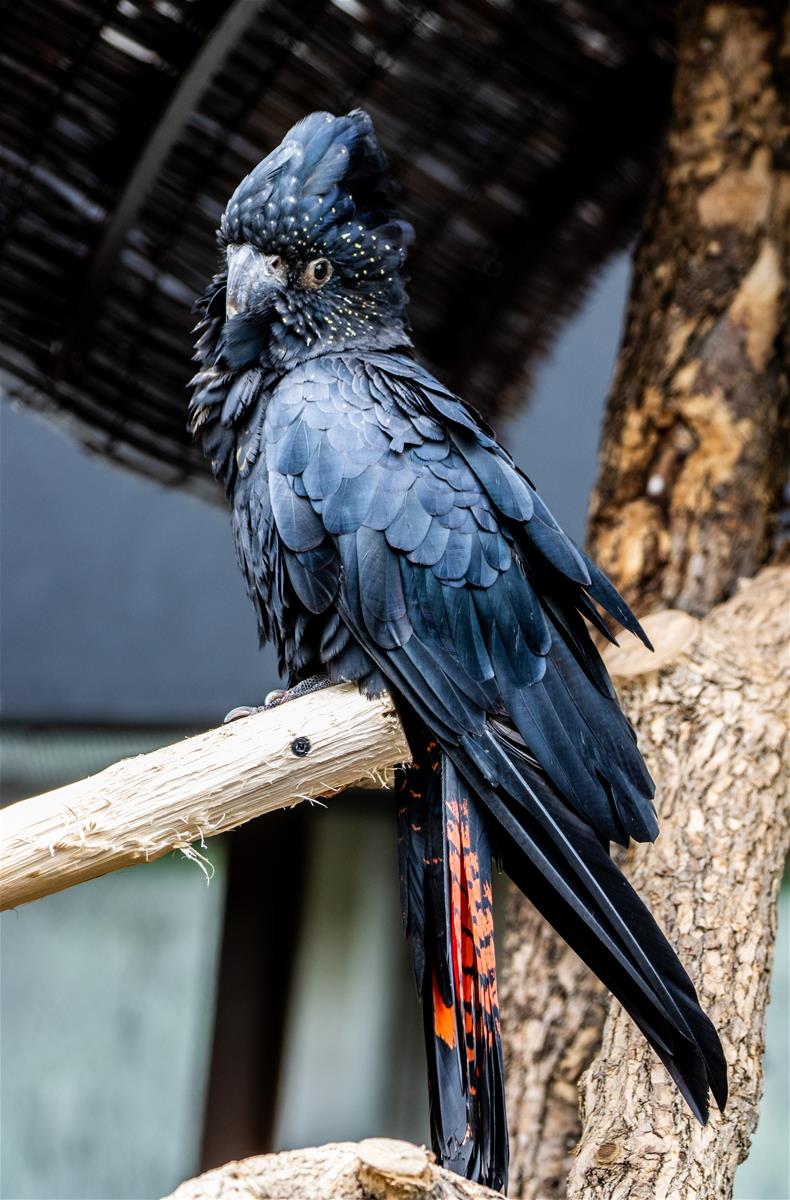Viewable


Bird
Location at the Zoo
Australasia
Global Range
Australia
Red-tailed black cockatoo
Calyptorhynchus banksii naso
Order: Psittaciformes
Family: Cacatuidae
Genus: Calyptorhynchus
The adult male's plumage is all black with a prominent black crest made up of elongated feathers from the forehead and crown. The tail is also black with two lateral bright red panels. The tail is about half of the body length. The bill is dark grey. Sexual dimorphism occurs. Females are brownish-black in colour, with paler underparts and yellow to whitish spots on the head, neck and wings. The breast and belly feathers have yellow to orange fringing and the black tail is barred with yellow to orange to red panels. The bill of the female is whitish-grey with a darker tip. In both sexes the upper beak hangs over the lower beak. Juveniles resemble females until puberty, which occurs around four years of age, but have paler yellow barred under parts. Males range from 670 to 920 grams and females from 617 to 870 grams. They are 53 - 60 centimetres in length.
There are three subspecies of the red-tailed black cockatoo in Western Australia and they vary in size and colouring. The forest red-tailed black cockatoo (Calyptorhynchus banksii naso) is slightly larger, with a heavier bill and a more brightly coloured female than the inland red-tailed black cockatoo (C. b. samueli). The northern red-tailed black cockatoo (C. b. macrorhynchus) is similar in appearance to the forest subspecies, except it has longer wings, a larger bill and the female's tail is barred with yellow, not orange.
There are three subspecies of the red-tailed black cockatoo in Western Australia and they vary in size and colouring. The forest red-tailed black cockatoo (Calyptorhynchus banksii naso) is slightly larger, with a heavier bill and a more brightly coloured female than the inland red-tailed black cockatoo (C. b. samueli). The northern red-tailed black cockatoo (C. b. macrorhynchus) is similar in appearance to the forest subspecies, except it has longer wings, a larger bill and the female's tail is barred with yellow, not orange.
Conservation Status: IUCN


Distribution
C. banksii naso is found in jarrah forests of southwestern Western Australia.Habitat
Red-tailed black cockatoos are often found in open woodland, riparian woodland, savannah, mulga, mallee, and rainforest. They prefer eucalyptus woodland but will inhabit all types of forests especially if there has been a recent fire. The forest red-tail lives in the crown of eucalypt forests.Diet
This subspecies feeds mainly on the large woody seeds of the marri (Eucalyptus calophylla).They also consume seeds from jarrah, blackbutt (E. patens), Albany blackbutt (E. staeri), karri, and forest sheoak (Allocasuarina).
Reproduction
The males begin courtship by puffing up crest and cheek feathers and hiding the beak. As courtship continues the male struts along a tree branch bowing towards the female, with his tail feathers fanned out, and his head feathers all ruffed up, giving a low, gurgling sound. This male breeding call is a repeated mechanical “waa-waa”. The calling and strutting ends with a flash of red tail feathers, directed towards the attentive female. Breeding takes place from March through to December.They nest in hollows of marri, jarrah and karri trees. They chew the inside of the nest hole to make a layer of wood chips on the bottom of the hollow. The female lays only one oval, white egg. For two or three weeks she will brood the egg day and night, while the male brings her food. After that, she will sit only at night, for a further week or so till the egg hatches. Hatchlings are covered in sparse yellow down. The hatchling soon becomes covered with dense yellow downy feathers. Both parents feed the young in the morning and the evening, entering the nest hollow tail-first. They grasp the beak of the young, and pump partially digested seeds from their own crops into the baby's beak.
The young bird is fledged in about 10 to 12 weeks. It will remain with its parents long after it has learned to fly, begging for food with a whispery, high-pitched whine. Even large birds will be fed regurgitated food by their parents. Young birds reach maturity in about four years. It takes four to five years before male birds attain their full adult plumage. As the birds reach maturity, males gradually replace their yellow tail feathers with red ones. These birds are very attentive of each other and their offspring. Pairs remain monogamous.
Adaptation
Cockatoos have very strong beaks which they use to break open very hard, woody seed capsules of gum trees. The forest red-tailed black cockatoo's upper beak hangs over the lower beak. The enlarged bill is thought to be an adaptation to feeding on marri nuts. It is used to open the base of these nuts to extract the seeds. Their very mobile, muscular tongue extracts the kernel from within the seed pod. Food items are often held in the foot, which has two toes pointing forward, and two pointing backwards. Having these zygodactylic feet allows them to move easily up and down branches in their arboreal environment. This is a characteristic of all parrot species. Red-tailed black cockatoos give a metallic, rolling, far-carrying “karee” or “krar-raak” call. They are quite raucous when in flight.Threats to Survival
Forest Red-tailed Cockatoos have a very low rate of reproduction which means the population cannot quickly replace the large number of birds that have died over the years. This species of Black Cockatoo only produces one young every second year, making it very difficult to increase the species’ numbers. It was formerly common, but is now rare to uncommon and patchily distributed over a range which has become markedly reduced. Habitat destruction is a major cause as cutting down trees destroys the cockatoos’ nesting sites.Black Cockatoos are also highly sought after as pets on the black market. Many chicks are taken from nests and trees are cut down to get at the eggs and babies inside the nesting hollows. This destroys the nesting site as well. It is now illegal to shoot or poach Black Cockatoos.












